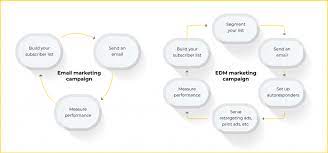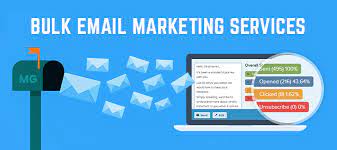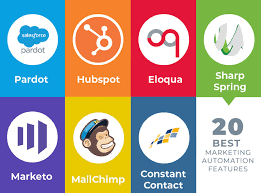Email Marketing for Affiliate Marketers: Boosting Conversions and Maximizing Profits
In the world of affiliate marketing, staying ahead of the competition is crucial. While there are various strategies to promote affiliate products, one method that consistently proves to be effective is email marketing. With its ability to reach a targeted audience and build long-term relationships, email marketing has become an indispensable tool for successful affiliate marketers.
Why Email Marketing?
Building Trust: Email marketing allows you to establish trust with your audience by delivering valuable content directly to their inbox. By consistently providing relevant information and helpful recommendations, you position yourself as an authority in your niche. This builds trust and credibility, making it more likely for subscribers to follow your recommendations and make purchases through your affiliate links.
Targeted Audience: Unlike other marketing channels, email marketing enables you to segment your audience based on their interests, preferences, or buying behavior. This segmentation allows you to tailor your messages specifically to each group’s needs, increasing the chances of engagement and conversions. By sending personalized emails that resonate with individual subscribers’ interests, you can significantly boost your conversion rates.
Cost-Effective: Compared to other advertising methods, email marketing is relatively cost-effective. With minimal overheads and the ability to automate campaigns using email service providers (ESPs), you can reach a large number of subscribers without breaking the bank. Additionally, as an affiliate marketer, you have the advantage of leveraging existing product promotions provided by merchants or vendors.
Tips for Effective Email Marketing:
Build a Quality Email List: Focus on building a quality email list rather than just accumulating a large number of subscribers. Encourage visitors on your website or blog to opt-in by offering valuable incentives such as exclusive content or freebies related to your niche. Ensure that subscribers have given explicit consent to receive emails from you in compliance with data protection regulations.
Personalize Your Emails: Take advantage of the segmentation capabilities offered by your ESP to send targeted emails. Address subscribers by their names and tailor the content to their specific interests or purchase history. Personalization creates a sense of individual attention, increasing engagement and conversions.
Engage with Valuable Content: Provide your subscribers with valuable content that solves their problems, educates them, or entertains them. Share industry insights, tips, and tutorials that align with your niche. By consistently delivering high-quality content, you establish yourself as a trusted source of information and increase the chances of conversions when promoting affiliate products.
Use Compelling Call-to-Actions (CTAs): When promoting affiliate products via email, ensure your CTAs are clear, compelling, and well-placed within the email. Use persuasive language that encourages readers to click through to the vendor’s website or landing page. A/B testing different CTAs can help you determine which ones generate the best results.
Monitor and Analyze Results: Regularly monitor your email marketing campaigns to analyze their performance. Track metrics such as open rates, click-through rates (CTRs), and conversion rates to identify areas for improvement. Experiment with different subject lines, email designs, or sending times to optimize your campaigns further.
Remember that building a successful email marketing strategy takes time and effort. Continuously test and refine your approach based on subscriber feedback and data analysis to achieve optimal results.
In conclusion, email marketing is an invaluable tool for affiliate marketers looking to boost conversions and maximize profits. By leveraging its ability to build trust, target specific audiences, and deliver personalized content, you can establish long-lasting relationships with subscribers while driving sales through your affiliate links. Embrace email marketing as an integral part of your affiliate marketing strategy and watch your business thrive in today’s competitive digital landscape.
5 Frequently Asked Questions About Email Marketing for Affiliate Marketers in the UK
- How do I create an effective email marketing campaign for affiliate marketers?
- What are the best practices for email marketing for affiliate marketers?
- How can I track the performance of my affiliate email campaigns?
- What are the most effective strategies for growing my list of subscribers?
- How do I ensure that my emails comply with data protection and privacy laws?
How do I create an effective email marketing campaign for affiliate marketers?
Creating an effective email marketing campaign for affiliate marketers requires careful planning and execution. Here are some steps to help you get started:
- Define Your Goals: Clearly define the objectives of your email marketing campaign. Are you looking to generate sales, increase brand awareness, or drive traffic to your website? Having a clear goal will shape your strategy and determine the metrics you need to track.
- Know Your Target Audience: Understand who your target audience is and what their needs and interests are. This will help you tailor your content and promotions to resonate with them. Segment your email list based on demographics, interests, or buying behavior to send more targeted messages.
- Build a Quality Email List: Focus on building an engaged and quality email list rather than just accumulating a large number of subscribers. Offer valuable incentives such as exclusive content, discounts, or freebies related to your niche in exchange for email sign-ups.
- Craft Compelling Subject Lines: Your subject line is crucial in grabbing the attention of subscribers and enticing them to open your emails. Make it concise, compelling, and relevant to the content inside the email. A/B test different subject lines to see which ones generate higher open rates.
- Provide Valuable Content: Deliver high-quality content that educates, entertains, or solves problems for your subscribers. Share industry insights, tips, tutorials, or product reviews related to your niche. By providing value consistently, you build trust with your audience and position yourself as an authority in your field.
- Promote Relevant Affiliate Products: Integrate affiliate product promotions within your emails strategically. Ensure that the products align with the interests and needs of your audience. Highlight the benefits of the products and explain how they can solve specific problems or enhance their lives.
- Use Persuasive Call-to-Actions (CTAs): Encourage readers to take action by using clear and persuasive CTAs in your emails. Make it easy for subscribers to click through to the vendor’s website or landing page. Use action-oriented language and create a sense of urgency when appropriate.
- Test and Optimize: Regularly monitor the performance of your email campaigns and analyze key metrics such as open rates, click-through rates, and conversion rates. A/B test different elements like subject lines, email designs, CTAs, or sending times to identify what resonates best with your audience. Continuously optimize your campaigns based on data insights.
- Ensure Mobile Responsiveness: With the majority of emails being opened on mobile devices, it is crucial to ensure that your emails are mobile-friendly. Optimize your design and layout for smaller screens to provide a seamless user experience across devices.
- Comply with Regulations: Familiarize yourself with email marketing regulations such as GDPR (General Data Protection Regulation) or CAN-SPAM Act to ensure compliance. Obtain explicit consent from subscribers and provide a clear option to unsubscribe from your emails.
Remember, building an effective email marketing campaign takes time and continuous refinement. Stay consistent, monitor results, and adapt your strategy based on subscriber feedback and data analysis to achieve optimal results in driving conversions as an affiliate marketer.
What are the best practices for email marketing for affiliate marketers?
Best Practices for Email Marketing for Affiliate Marketers:
- Build a Quality Email List: Focus on attracting subscribers who are genuinely interested in your niche and the products you promote. Offer valuable incentives to encourage opt-ins and ensure that subscribers have given explicit consent to receive emails from you.
- Segment Your Audience: Divide your email list into different segments based on demographics, interests, or buying behavior. This allows you to send targeted emails that resonate with each group’s specific needs and preferences.
- Personalize Your Emails: Address subscribers by their names and tailor the content to their individual interests. Leverage the data you have collected to send personalized recommendations and offers, creating a sense of individual attention.
- Provide Valuable Content: Deliver high-quality content that solves problems, educates, or entertains your subscribers. Share industry insights, tips, and tutorials related to your niche. By consistently providing value, you establish yourself as a trusted source of information.
- Balance Promotional and Non-Promotional Emails: While promoting affiliate products is essential, avoid bombarding your subscribers with constant sales pitches. Strike a balance between promotional emails and non-promotional content that adds value to their lives.
- Use Compelling Subject Lines: Craft attention-grabbing subject lines that entice subscribers to open your emails. Experiment with different approaches such as curiosity, urgency, or personalization to increase open rates.
- Create Engaging Email Designs: Design visually appealing emails that are easy to read and navigate across devices. Use images, videos, and clear call-to-action buttons to guide subscribers towards taking the desired action.
- Optimize for Mobile Devices: Ensure that your emails are mobile-friendly since a significant portion of users access their emails on smartphones or tablets. Test your emails on various devices and email clients to ensure they display correctly.
- Test and Measure Results: Continuously test different elements of your email campaigns such as subject lines, content, CTAs, and sending times. Analyze key metrics like open rates, click-through rates (CTRs), and conversion rates to identify areas for improvement.
- Comply with Regulations: Familiarize yourself with data protection regulations such as GDPR or CAN-SPAM Act to ensure you are collecting and using subscriber data in a compliant manner. Provide clear unsubscribe options and honor opt-out requests promptly.
- Monitor Affiliate Program Policies: Stay updated with the terms and conditions of the affiliate programs you promote. Adhere to their guidelines regarding email marketing practices to maintain a good relationship with merchants or vendors.
- Maintain Consistency: Develop a consistent email schedule so that subscribers know when to expect your emails. Whether it’s weekly newsletters or monthly product recommendations, be reliable in your communication.
By following these best practices, you can maximize the effectiveness of your email marketing efforts as an affiliate marketer while building trust and driving conversions among your subscribers.
How can I track the performance of my affiliate email campaigns?
Tracking the performance of your affiliate email campaigns is essential to gauge their effectiveness and make data-driven decisions for optimization. Here are some key metrics and strategies to track and analyze the performance of your affiliate email campaigns:
- Open Rates: Monitor the percentage of recipients who open your emails. A low open rate may indicate issues with your subject lines, sender name, or email timing. Experiment with different subject lines and analyze which ones generate higher open rates.
- Click-Through Rates (CTRs): Measure the percentage of recipients who click on the links within your emails. CTRs indicate how engaging your content is and how well your call-to-action (CTA) resonates with your audience. Test different CTAs, placement of links, and email designs to optimize CTRs.
- Conversion Rates: Track the percentage of recipients who complete a desired action after clicking on your affiliate links, such as making a purchase or signing up for a service. This metric directly reflects the effectiveness of your email campaign in driving conversions.
- Revenue Generated: Calculate the revenue generated from each email campaign by tracking the sales or commissions earned through your affiliate links. This metric helps you assess the profitability of specific campaigns and identify areas for improvement.
- List Growth: Monitor how effectively you are growing your email list by tracking subscriber acquisition rates, unsubscribe rates, and overall list growth over time. A healthy and engaged subscriber base is crucial for successful email marketing.
- A/B Testing: Conduct split tests by creating variations of your emails (e.g., subject lines, CTAs, content) to compare their performance against each other. This allows you to identify what resonates best with your audience and optimize future campaigns accordingly.
- Email Deliverability: Keep an eye on bounce rates (emails that were not delivered) and spam complaint rates to ensure that your emails are reaching subscribers’ inboxes effectively. Maintaining good deliverability requires maintaining a clean and engaged email list.
- Tracking Tools: Utilize email marketing platforms that offer analytics and tracking features, such as click tracking, conversion tracking, and campaign reports. These tools provide insights into your campaign performance and help you make data-driven decisions.
Regularly analyze these metrics to identify trends, patterns, and areas for improvement. Experiment with different strategies, content types, and audience segmentation to optimize your affiliate email campaigns over time. Remember that tracking performance is an ongoing process that requires continuous monitoring and refinement to achieve optimal results.
What are the most effective strategies for growing my list of subscribers?
Growing your list of subscribers is essential for the success of your email marketing campaigns. Here are some effective strategies to help you expand your subscriber base:
- Offer Valuable Incentives: Create compelling lead magnets or opt-in incentives that provide value to your target audience. This could include e-books, guides, checklists, templates, exclusive content, discounts, or access to a members-only area on your website. Make sure the incentive is relevant to your niche and appeals to your audience’s needs and desires.
- Optimize Your Website for Opt-ins: Place prominent and visually appealing opt-in forms on strategic areas of your website, such as the homepage, sidebar, footer, or within blog posts. Use attention-grabbing headlines and clear calls-to-action (CTAs) that encourage visitors to subscribe. Consider using pop-up or slide-in forms with exit-intent technology to capture visitors who are about to leave your site.
- Leverage Social Media: Utilize social media platforms to promote your email list and encourage sign-ups. Create engaging posts that highlight the benefits of subscribing and direct followers to a dedicated landing page or opt-in form on your website. Run contests or giveaways that require participants to sign up for your email list for a chance to win.
- Guest Blogging and Collaborations: Write guest blog posts for popular websites in your niche and include a bio with a link back to your own website’s opt-in form. Collaborate with other influencers or complementary businesses in joint ventures where you can cross-promote each other’s email lists.
- Use Content Upgrades: Offer additional valuable content upgrades within individual blog posts or articles on your website. These upgrades can be specific resources related to the topic of the post that readers can access by providing their email address.
- Webinars and Events: Host webinars or online events where participants need to register with their email addresses for access. Provide valuable insights or training during the event to make it enticing for attendees to sign up.
- Referral Programs: Implement a referral program where existing subscribers can earn rewards or exclusive content by referring their friends or colleagues to join your email list. This can help incentivize word-of-mouth marketing and grow your subscriber base organically.
- Use Paid Advertising: Consider investing in targeted advertising campaigns, such as social media ads or search engine marketing, to drive traffic to your opt-in forms. Ensure that your ads clearly communicate the value of subscribing and entice users to take action.
- Optimize Landing Pages: Create dedicated landing pages with persuasive copy, compelling visuals, and a clear opt-in form. Remove distractions and focus on highlighting the benefits of subscribing. A/B test different elements, such as headlines, imagery, and form placement, to optimize conversion rates.
- Engage with Your Audience: Regularly engage with your audience through blog comments, social media interactions, or email responses. Build relationships and provide value by addressing their questions or concerns directly. This will help foster trust and encourage more people to subscribe.
Remember that growing your subscriber list is an ongoing process that requires consistency and experimentation. Continuously evaluate the effectiveness of each strategy and adapt based on feedback and data analysis to achieve optimal results for your specific audience and niche.
How do I ensure that my emails comply with data protection and privacy laws?
Ensuring compliance with data protection and privacy laws is crucial when conducting email marketing. Here are some key steps to follow:
- Obtain Explicit Consent: Ensure that you have obtained explicit consent from individuals before adding them to your email list. Use an opt-in form that clearly explains what type of emails they will receive and how their personal information will be used. Avoid pre-checked boxes or assuming consent.
- Provide Transparency: Be transparent about your data collection practices and clearly state how you will handle and protect subscribers’ personal information. Include a privacy policy on your website that outlines your data processing practices, such as how you store, secure, and use subscriber data.
- Allow Easy Unsubscribing: Make it simple for subscribers to unsubscribe from your emails by including an unsubscribe link in every email you send. Honor unsubscribe requests promptly to demonstrate respect for subscribers’ choices.
- Implement Data Security Measures: Take appropriate measures to protect the personal data collected from subscribers. This includes using secure servers, encryption methods, and regularly updating software to prevent unauthorized access or data breaches.
- Comply with Anti-Spam Laws: Familiarize yourself with anti-spam laws in the jurisdictions where your subscribers are located (e.g., CAN-SPAM Act in the US, GDPR in the EU). Follow these laws by including accurate sender information, a clear subject line, and a valid physical address in your emails.
- Maintain Data Accuracy: Regularly review and update subscriber information to ensure its accuracy and relevance. Remove inactive or unengaged subscribers who haven’t interacted with your emails for an extended period.
- Partner with Compliant Service Providers: If you use an Email Service Provider (ESP) or any other third-party service for email marketing, ensure they have robust privacy policies and comply with relevant data protection regulations.
- Stay Informed about Regulatory Changes: Keep up-to-date with changes in data protection and privacy laws, as they can evolve over time. Regularly review and revise your practices to align with any new requirements or guidelines.
Remember, this guidance is not legal advice. It is essential to consult with a legal professional who specializes in data protection and privacy laws to ensure full compliance with applicable regulations in your jurisdiction.




